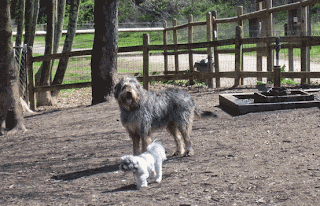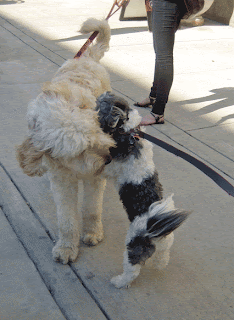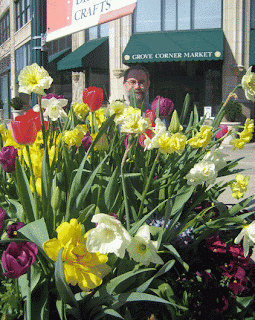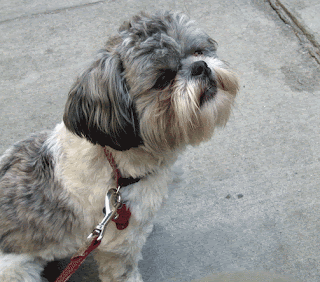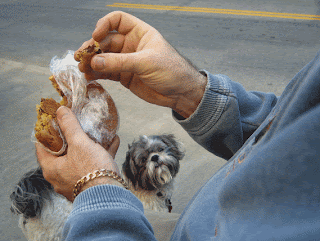There's a special type of creativity that makes art from the mundane. I love this animated stop-motion video, Deadline, by Bang-yao Liu. It was his senior project at Savannah College of Art and Design. Liu says: "where my idea comes from is that every time when I am busy, I feel not that I am fighting with my work,...I am fighting with those post-it notes and deadlines."
The second video is about the making of Deadline.
Deadline
Directed by Bang-yao Liu
Music by Röyksopp (http://royksopp.com)
Sound design by Ian Vargo, Shaun Burdick
Actor: Chun-yao Huang
The Making of 'Deadline'
Filmed by Jay Tseng
Edited by Bang-yao Liu
7.11.2009
6.26.2009
Tim Burton's Alice in Wonderland
 I was delighted to hear that we'll be seeing director Tim Burton's Alice in Wonderland next year. Lewis Carroll's Alice's Adventures in Wonderland (read and see the facsimile of the original book, with Arthur Rackham's illustrations, here) and Through the Looking Glass (read here) are two of my early favorite books, and anything by Burton (his most recent film was his version of Stephen Sondheim's Sweeney Todd) is bound to be, at the very least, a visual treat. The cast includes Johnny Depp as the Mad Hatter, Helen Bonham Carter (Burton's wife) as the Red Queen, Anne Hathaway as the White Queen, Stephen Fry as the Cheshire Cat and Mia Wasikowska as Alice.
I was delighted to hear that we'll be seeing director Tim Burton's Alice in Wonderland next year. Lewis Carroll's Alice's Adventures in Wonderland (read and see the facsimile of the original book, with Arthur Rackham's illustrations, here) and Through the Looking Glass (read here) are two of my early favorite books, and anything by Burton (his most recent film was his version of Stephen Sondheim's Sweeney Todd) is bound to be, at the very least, a visual treat. The cast includes Johnny Depp as the Mad Hatter, Helen Bonham Carter (Burton's wife) as the Red Queen, Anne Hathaway as the White Queen, Stephen Fry as the Cheshire Cat and Mia Wasikowska as Alice.According to Burton in an article in Disney's new magazine, Disney Twenty-Three, the new film is not a re-telling of the 1865 novel, but a new story that has Alice returning to Wonderland, as a teenager, several years after the events of Alice's Adventures in Wonderland and Through the Looking Glass. He describes the movie as "kind of a mixture of some distorted live action and animation." Hmmmm.
Here are a few of the images that recently were released by Disney to give a feel for Burton's artistic concept. You can find more images here and here. I'm looking forward to learning more.

5.20.2009
Making Books with Andrea Dezsö
 I wrote in this blog about Andrea Dezsö a year-and-a-half ago. I began with "How smitten am I with Andrea Dezsö?" Well, I'm even more smitten now. When I found out that Andrea was teaching at the Southeast Association for Book Arts (SABA) conference, a scant two-and-a-half-hour-drive away, I signed up immediately. I didn't even read the description of the class.
I wrote in this blog about Andrea Dezsö a year-and-a-half ago. I began with "How smitten am I with Andrea Dezsö?" Well, I'm even more smitten now. When I found out that Andrea was teaching at the Southeast Association for Book Arts (SABA) conference, a scant two-and-a-half-hour-drive away, I signed up immediately. I didn't even read the description of the class. As it turned out, the two-day class covered tunnel books on day 1 and pop-up books on day 2. Andrea, whose regular day job is at Parsons New School for Design (you can see her work here on Parson's site -- including her pop-up and tunnel books), kept things simple. She doesn't believe in showing students how to replicate one of her books; she prefers to teach them the form and let them experiment with their own ideas. During our class, Andrea was available to guide, demonstrate, and answer questions, but made a point of not imposing her aesthetic on us.
She showed us two alternatives for a tunnel book: the first was the more traditional accordion style; the other is a, simpler, wrap-around format. In the latter, each individual "screen," or portion, of the tunnel book has side tabs that are are affixed to a long strip of the same material. The strip "wraps" around the sides and back of the book. You can see some of the work our class created at the end of this post. And I couldn't resist including some images of Andrea's tunnel and pop-up books.
This is the first time I'd attended the SABA conference, which is organized by the Art Department at the University of South Carolina in Columbia, and held there for four days every two years. The organizers are a mix of members of the Art and English departments at USC, and they did a terrific job. Each day began with a presentation from one of the instructors, and lunch included a lecture or workshop by someone from the school -- for example, the head of the university's rare books collections spoke on what book artists can learn from such a collection's resources. A national exhibit of artists' books, Intimate Curiosities, was mounted in conjunction with the conference, juried by artist Bea Nettles (Bea also took Andrea's class) and the opening of the exhibit was held at the University's McMaster Gallery during the first evening of the conference. Magnolia trees were in full bloom in Columbia during our visit, and Andrea, who'd never seen the flowers, was immediately captivated, saying that they were "as big as a person's head!" (As a side note, she made some beautiful sketches, including of the flower and its striking seed pod, during class).
I was delighted with the entire experience: with the professional and still friendly way in which the conference was run, with the organizers and speakers from USC, with the exhibit, with my fellow students, and of course, with the program and the instructors (and a good word, too, for The Inn at USC, which gave us great rates, and cookies and milk every night). I'm only sorry that it comes around only once every two years.
If you'll be in New York City between October 2009 and January 2010, check out the Museum of Art & Design's show: Slash: Paper Under the Knife, an international exhibit that will include Andrea's work.
(Note: the image at top right is Andrea Dezsö's tunnel book: Living Inside: The Forest. Andrea mentioned that this book was stolen from a gallery in April 2008. If you learn its whereabouts, please contact Andrea via her "Contact" link at Parsons.)
4.22.2009
Lisa Hannigan - Handmade
 Is it just me, or are we seeing a surge of of pop-up-book art and paper-cuts art? I know we're seeing a renewed interest in and appreciation for the handmade object. Singer and songwriter Lisa Hannigan's new CD, Sea Sew, and the promotion for the disc, incorporate all three of these elements. Hannigan hails from Ireland, and sang backup for Damien Rice before being fired by him after seven years (see this NPR interview).
Is it just me, or are we seeing a surge of of pop-up-book art and paper-cuts art? I know we're seeing a renewed interest in and appreciation for the handmade object. Singer and songwriter Lisa Hannigan's new CD, Sea Sew, and the promotion for the disc, incorporate all three of these elements. Hannigan hails from Ireland, and sang backup for Damien Rice before being fired by him after seven years (see this NPR interview).The central image for the web site for Sea Sew is a piece of knitting by Hannigan's mother. The original liner notes (song lyrics), photographed and included in the CD package, were hand-embroidered by Lisa (see the lyrics for Keep It All above). The song Lille -- the first of the two videos below -- is illustrated by pop-up imagery. That's Hannigan turning the pages. The pop-ups are by Maeve Clancy and Jamie Hannigan. The second, I Don't Know, has Hannigan literally "cutting-and-pasting" a room for herself (also created by Clancy). You can buy the album here and here. I love both of the songs and videos and have been playing them all afternoon.
Hannigan's blog entry for March 10, 2009 recounts her appearance on The Colbert Report. Catch that interview and performance here and here. Image credit for Keep It All lyrics (above): ATO Records. Thanks to Blue Roof Designs for the heads-up.
"Lille"
4.20.2009
Making Paste Paper
 I had the great good fortune to take part in a paste paper* workshop with Larry Lou Foster recently. Larry Lou (Louise Lawrence Foster), a book artist and fine binder, is a respected expert and innovator in paste-paper design. She has studied paste-paper traditions extensively and, over the years, replicated many historical patterns, as well as created new designs. It was a delightful and intense two days of work and study. Larry Lou is as generous as she is knowledgeable, and she was determined to share with us as many of her techniques and insights as our time with her allowed.
I had the great good fortune to take part in a paste paper* workshop with Larry Lou Foster recently. Larry Lou (Louise Lawrence Foster), a book artist and fine binder, is a respected expert and innovator in paste-paper design. She has studied paste-paper traditions extensively and, over the years, replicated many historical patterns, as well as created new designs. It was a delightful and intense two days of work and study. Larry Lou is as generous as she is knowledgeable, and she was determined to share with us as many of her techniques and insights as our time with her allowed.Printer, paper maker and book artist Frank Brannon, who met Larry Lou while in the MFA in Book Arts program at the University of Alabama, introduced Larry Lou to Laurie Corral, director of Asheville BookWorks, who immediately engaged her for a weekend workshop this spring. Frank is working on an edition of a book that will contain many examples of Larry Lou's paste papers, along with a discussion of her work. He not only designed the book and letterpress-printed the text, but made the paper for it as well. Once he's incorporated Larry Lou's paste-paper samples, which she created for the edition, he'll bind the books and make them available for sale.
Here are a few photos from the workshop. All of the paste papers pictured are Larry Lou's, although each of us who took the workshop came home came home with a lovely and ample supply of our own paper for book covers, boxes, cards, collage, etc.
* Paste papers are one of the earliest forms of decorative paper, first used in the 17th century for covers and end papers in books. Many of the beautiful and intricate designs of these papers are being used as inspiration by today's paste paper artists, who are also creating wonderful contemporary designs. The "paste" in "paste paper" is usually a wheat- or rice-paste mixture, to which pigment (acrylic paint or ground pigment) has been added. The colored paste is brushed onto dampened paper, then a variety of objects -- kitchen tools, carved brayers, and found objects, -- are used to draw into the paste while it is still wet. For those of you who may not have the convenience of a class, one of the best books on paste papers is Diane Maurer-Mathison's The Art of Making Paste Papers.
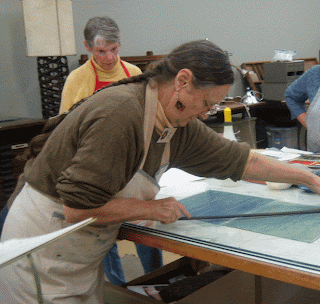 Larry Lou, using a long dowel to create diagonal lines on the paper,
Larry Lou, using a long dowel to create diagonal lines on the paper,over which she'll draw a design.
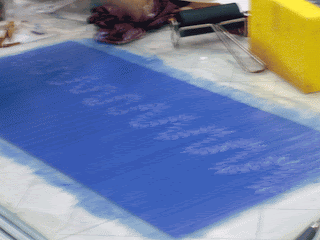
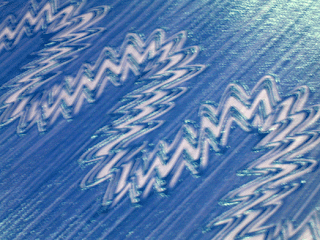
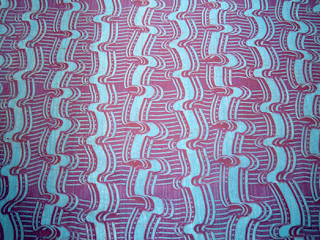
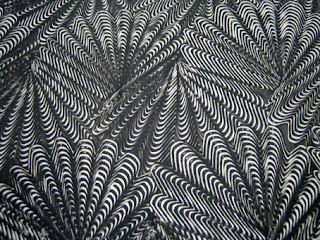
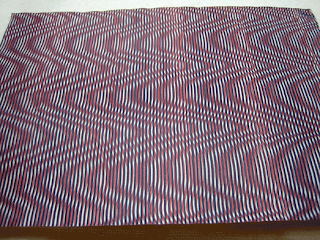

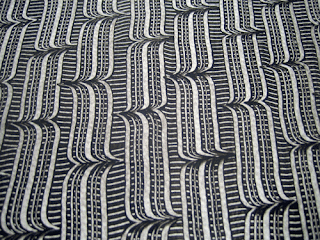
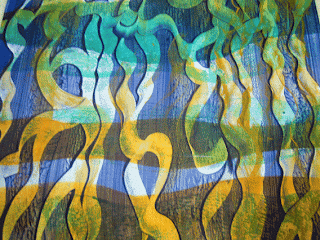
4.06.2009
Sunday in the Park With...
 A digression from "bookishness" today: I thought I'd share some photos of our outing yesterday with our two pups. We're fortunate to have several dog parks in the area, and we visited one of them for the first time yesterday afternoon. Coco (in spite of being the youngest and smallest of our two dogs, and among the smallest at the park), immediately took to the adventure. (That's Coco to the right, being "chauffered" to the park.) She made friends with everyone, dogs and people alike, and ran as fast as her very-close-to-the-ground legs would carry her. Twiggy, a more tentative pup, stuck close to me and Steven, venturing out only when Coco was with him. I was impressed at how well-behaved all the dogs were at the park. None of them showed any aggression, and all welcomed Coco's friendly overtures.
A digression from "bookishness" today: I thought I'd share some photos of our outing yesterday with our two pups. We're fortunate to have several dog parks in the area, and we visited one of them for the first time yesterday afternoon. Coco (in spite of being the youngest and smallest of our two dogs, and among the smallest at the park), immediately took to the adventure. (That's Coco to the right, being "chauffered" to the park.) She made friends with everyone, dogs and people alike, and ran as fast as her very-close-to-the-ground legs would carry her. Twiggy, a more tentative pup, stuck close to me and Steven, venturing out only when Coco was with him. I was impressed at how well-behaved all the dogs were at the park. None of them showed any aggression, and all welcomed Coco's friendly overtures.Next we headed downtown for a stroll. We live in a very dog-friendly place, so we can always depend on finding other people walking their dogs downtown on a weekend. Many shops allow pets inside, too. Twiggy and Coco had a great time exploring, then, when we took a break for hot cocoa and cookie, watching dogs and their people walk by.
This "puppy love" is a relatively new state of affairs for me. I've never been much of a pet person, and were it not for Steven, I doubt I'd ever have shared my home with an animal. Once we were married, 'though, Steven started to work on me, slowly but insistently, until I said 'yes' to bringing Twiggy home a little over four years ago. I still have a hard time believing that I agreed to a second dog (might Steven have put something in the water?). Nevertheless, I'm now besotted with Twiggy and Coco, and I've become one of those people to whom I used to feel superior while smiling indulgently as they talked about (and to) their dogs.
There's a moral here somewhere. Maybe one of them is that it's sometimes good to let go of old biases and welcome the unexpected.
Oh, by the way, Twiggy has his own blog (yes, clearly I've gone over the edge). He took a break after Coco arrived -- she's quite a handful -- but he expects to be posting more regularly again.
3.21.2009
Gocco
 I bought a Gocco (from a Japanese word loosely translated as "make-believe play") more than a year ago, and I've yet to use it. Mind you, when I learned that the manufacturer was going to stop making Gocco and shipping supplies to the U.S. in December 2008 (see here and here), I stocked up on inks, screens, and bulbs in a panic. But, nooooo, that didn't motivate me to actually use my Gocco. The Gocco and the supplies still sit on my shelf, untouched.
I bought a Gocco (from a Japanese word loosely translated as "make-believe play") more than a year ago, and I've yet to use it. Mind you, when I learned that the manufacturer was going to stop making Gocco and shipping supplies to the U.S. in December 2008 (see here and here), I stocked up on inks, screens, and bulbs in a panic. But, nooooo, that didn't motivate me to actually use my Gocco. The Gocco and the supplies still sit on my shelf, untouched.I don't know about you, but I'm pretty visual when it comes to learning how to make something. But I also need to hear the instructions -- for some reason, visuals without words don't seem to take -- so the best combination for me is both hearing the instructions and seeing the action.
So I was delighted when I came across this video (below) from Etsy Labs on YouTube. Not only does it promise that Gocco printing is insanely simple, but it shows this to be really, truly so. So for all of you who have been procrastinating about making Gocco prints (to use in your books, natch), you have no excuse now (I'm saying that to myself as well as to you). Get out your Gocco and print!
P.S. Here are some FAQs about Gocco, should you want to learn more. And for inspiration, the beautiful Gocco print shown above is by Yellena, who has some gocco prints among the work for sale in her Etsy shop. And here's a gorgeous multi-color Gocco print from nebo peklo and some lovely work from Two Guitars, including these cards:

Gocco Printing From Etsy Labs
3.10.2009
The Journey
This is a wonderful short video based on the recordings of Alan Watts (1915-1973), produced by Trey Parker and Matt Stone, the creators of South Park. Watts was a British philosopher and writer. He was well known for his writings and lectures on Eastern philosophy and religion and the nature of reality. I initially read his work years ago, when it seemed everyone was enamored of all things "Zen." His words, which then had the air of fashion, are now simply real and true. Here, Watts talks about likening our lives to music, that is, savoring the journey.
(Parker and Stone have produced several videos based on Watts' recordings, including Prickles & Goo, based on names Watts assigned to personality types. For Gumby aficionados, this is where Gumby creator Art Clokey got the names for Gumby's pals -- Clokey was Watts' lifelong friend).
(Parker and Stone have produced several videos based on Watts' recordings, including Prickles & Goo, based on names Watts assigned to personality types. For Gumby aficionados, this is where Gumby creator Art Clokey got the names for Gumby's pals -- Clokey was Watts' lifelong friend).
3.02.2009
Margaret Kilgallen
 The late Margaret Kilgallen was a central figure in the San Francisco Bay area street art movement. She was influenced by American folk art, hand-painted signs, typography, and symbology. I was first drawn to her because of her dynamic images and lettering, and only recently learned that she was a bookbinder and had been a book conservator at the San Francisco Public Library. In addition to her mural work, Kilgallen also worked on found paper -- including discarded book endpapers, -- reflecting, it seems, her book arts background.
The late Margaret Kilgallen was a central figure in the San Francisco Bay area street art movement. She was influenced by American folk art, hand-painted signs, typography, and symbology. I was first drawn to her because of her dynamic images and lettering, and only recently learned that she was a bookbinder and had been a book conservator at the San Francisco Public Library. In addition to her mural work, Kilgallen also worked on found paper -- including discarded book endpapers, -- reflecting, it seems, her book arts background.The first season of the PBS documentary series Art:21 profiled Kilgallen, and had this to say about her:
"Early experiences as a librarian and bookbinder contribute to her encyclopedic knowledge of signs drawn from American folk tradition, printmaking, and letterpress. Painting directly on the wall, Kilgallen creates room-size murals that recall a time when personal craft and handmade signs were the dominant aesthetic. Strong, independent women walking, surfing, fighting, and biking feature prominently in the artist’s compositions. Her work has been shown at Deitch Projects and the Drawing Room in New York, Yerba Buena Center for the Arts and the Luggage Store in San Francisco, the Forum for Contemporary Art in St. Louis, and the Institute of Contemporary Art in Boston. Kilgallen’s work was recently presented at the UCLA/Armand Hammer Museum. She died in June 2001 in San Francisco, where she lived with her husband, Barry McGee."*In the Art:21 documentary Kilgallen says:
"I like things that are handmade and I like to see people's hand in the world, anywhere in the world; it doesn't matter to me where it is. And in my own work, I do everything by hand. I don't project or use anything mechanical, because even though I do spend a lot of time trying to perfect my line work and my hand, my hand will always be imperfect because it's human. And I think it's the part that's off that's interesting, that even if I'm doing really big letters and I spend a lot of time going over the line and over the line and trying to make it straight, I'll never be able to make it straight. From a distance it might look straight, but when you get close up, you can always see the line waver. And I think that's where the beauty is."This snippet of the documentary shows Kilgallen working,; she also talks about her influences.
You can read the Art:21 interview with Kilgallen here, and see images of Kilgallen's work on Flickr here.
*sadly, Kilgallen died at 33, of complications from breast cancer, three weeks after the birth of her daughter.
Image Credit: Work on paper from installation at UCLA Armand Hammer Museum, Los Angeles, 2000. Photo by Robert Wedemeyer
2.27.2009
Creavity a la Tharp
 I've been reading Twyla Tharp's book The Creative Habit. In addition to thinking that she's a terrific choreographer and dancer, I have a soft spot for Ms. Tharp. For my 30th birthday, two of my friends from high school flew me Washington, D.C. to see her company perform at The Kennedy Center. Not too longer after that, in Miami, I saw Mikhail Baryshnikov dance (beautifully) in Tharp's Sinatra Suite and
I've been reading Twyla Tharp's book The Creative Habit. In addition to thinking that she's a terrific choreographer and dancer, I have a soft spot for Ms. Tharp. For my 30th birthday, two of my friends from high school flew me Washington, D.C. to see her company perform at The Kennedy Center. Not too longer after that, in Miami, I saw Mikhail Baryshnikov dance (beautifully) in Tharp's Sinatra Suite and Push Comes to Shove, which Baryshnikov had commissioned for American Ballet Theater, and I was hooked.
I read 80 pages of the book this afternoon in one sitting, partly because I find Tharp's message compelling, and partly because I find her dedicated approach to her art appealing. She's of the school that believes that talent doesn't count for much unless you're prepared to work hard and consistently. And that's much of what the book is about: setting work habits that foster the conditions in which creativity is most likely to flower. Here's some of what I jotted in my Moleskine this afternoon while I was reading:
"When I'm unable to shake my fears sufficiently, I borrow a biblical epigraph from Dostoyevsky's The Demons:" I see my fears being cast into the bodies of wild boars and hogs and I watch them rush to a cliff where they fall to their deaths." [beats counting sheep.]Here's Baryshnikov in a bit of Tharp's Sinatra Suite and in Push Comes to Shove, for old times' sake:
"The other obstacle to good work is distractions. When I commit to a project I don't expand my contact with the world; I try to cut it off...I list the biggest distractions in my life and make a pact with myself to do without them for a week." [she cuts out movies, multi-tasking, "numbers," and music. Add the Internet for me.] "Subtracting your dependence on some of the things you take for granted increases your independence." and
"There's a difference between a work's beginning and beginning to work." [In other words, starting to work doesn't necessarily mean that you know how the work will begin.] "Just start. You never know where it will take you."
2.09.2009
What I'm Listening To Today
Forgive the digression from books today.
Oren Lavie: Her Morning Elegance
According to Lavie's blog on MySpace, the video is made up of roughly 3225 still photos, using one camera hanging from the ceiling. It took four weeks before the shooting to create the animated storyboard for the video, using 3-D dummies.
More about Lavie here, who in addition to writing songs, writes plays and children's books. Thanks to Steven for the heads up.
Oren Lavie: Her Morning Elegance
According to Lavie's blog on MySpace, the video is made up of roughly 3225 still photos, using one camera hanging from the ceiling. It took four weeks before the shooting to create the animated storyboard for the video, using 3-D dummies.
More about Lavie here, who in addition to writing songs, writes plays and children's books. Thanks to Steven for the heads up.
2.06.2009
2008 Reading Redux
 As usual, there were some standouts in the year's (2008) reading, as well as some clunkers. Reading is such a personal experience, 'though, that I hesitate to mention the latter, since my clunker may someone else's well-oiled machine. I'm reminded of The Memory Keeper's Daughter, which I read in '07 and thoroughly, deeply disliked. It was a selection of my book club, and at least half of the group -- and we have a large group -- thought it was terrific.
As usual, there were some standouts in the year's (2008) reading, as well as some clunkers. Reading is such a personal experience, 'though, that I hesitate to mention the latter, since my clunker may someone else's well-oiled machine. I'm reminded of The Memory Keeper's Daughter, which I read in '07 and thoroughly, deeply disliked. It was a selection of my book club, and at least half of the group -- and we have a large group -- thought it was terrific. I had a great time reading or re-reading several classics -- Jane Eyre, especially. I'd forgotten what a smart and strong (and feminist) character Jane is. (I was so taken with the book that I wrote about it here.) I enjoyed my sojourn into Henry James country, re-reading some novels and savoring some short stories for the first time. I went on a bit of a Henry James jag and also read a very good biography, The Mature Master, the second of two volumes on James by Sheldon Novick, and an equally good fictional version of James's literary life by David Lodge: Author, Author.
Other books that have stayed with me -- which is one way I judge a book's value, with the caveat that some of the truly bad ones also won't go away -- include When Will There Be Good News, the third book in British author Kate Atkinson's series about Jackson Brodie (wonderfully written and cleverly crafted); A Long Way Down, by Nick Hornby (as usual in Hornby's work, funny and touching at the same time, but never sentimental); Per Petterson's Out Stealing Horses (a quiet, lyrical novel), Child 44, by Tom Robb Smith (a compelling thriller set in Russia during Stalin's regime), and The Suspicions of Mr Whicher, by Kate Summerscale. This last focuses on the actual murder of a child in 1860s England, and Summerscale uses her extensive research to explore the rise of the English detective and his role in English society. Wilkie Collins' The Moonstone, which I'm reading now, and which was written a few years after the case described in Summerscale's book, borrows much from that book's real-life detective.
I loved Three Junes, Julia Glass's first novel, which I came to late, after having read and enjoyed The Whole World Over a couple of years ago. I liked Willilam Gay's Twilight (no, not that Twilight), a strange, striking novel set in the Tennessee country in which the author lives; enjoyed The Accidental Masterpiece, essays on art and artists by Michael Kimmelman, and Valentines, a slim volume of poetry by Ted Kooser; and was nourished by poet Kathleen Norris's thoughtful The Cloister Walk, about her retreats in a Benedictine monastery.
Thankfully, I didn't read anything last year as unfortunate as The Memory Keeper's Daughter. Still, there were ho-hum books, the kind that take up time that could have been spent reading something one enjoys more. Among these were In the Garden of Iden, The Society of S, The Spellman Files, The Writing Diet, (a weight-loss book by Julia Cameron of Artist's Way fame) and Zen and the Art of Motorcyle Maintenance (what's with all the fuss over the years about this one?). But, as one good friend says: "If you like this kind of thing, then this is the kind of thing you'll like."
Here's to all the books yet to be explored in 2009. Happy reading.
[Photo Credit: Woman Reading by Henri Matisse]
1.27.2009
Crowned for the Holidays
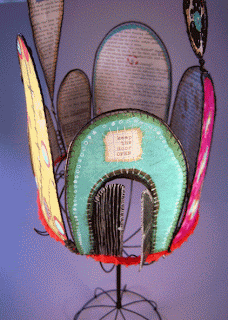 When I returned from Penland last summer, I wrote here about artist and friend Margaret Couch Cogswell, who is currently a Penland resident artist. As you may have gathered from that post, I think her work is terrific. There's much to like: her versatility, her sense of color, the surprising ways in which she combines media. I think, 'though, that what I appreciate most is the sensibilities Margaret brings to her art, which resonate for me.
When I returned from Penland last summer, I wrote here about artist and friend Margaret Couch Cogswell, who is currently a Penland resident artist. As you may have gathered from that post, I think her work is terrific. There's much to like: her versatility, her sense of color, the surprising ways in which she combines media. I think, 'though, that what I appreciate most is the sensibilities Margaret brings to her art, which resonate for me.So when my husband surprised me on Christmas day with a piece he'd commissioned from Margaret, I was more than delighted. I'm not easy to surprise, and my husband is not good at keeping secrets, so how I managed to open the box without even the tiniest inkling of its contents still amazes me. He knew I would love one of Margaret's crowns, but I'm told that the only guideline he offered her was that she should incorporate the concept of keeping doors open to creativity (no doubt in part because I tend to be just a tad (!) hard on myself about my own creations).
I can't imagine changing a thing about this beautiful piece. It inspires me each time I look at it. Margaret will soon launch a blog, and she's also in the process of building a web site, so you'll be able to see a good deal more of her work online -- and make it your own.
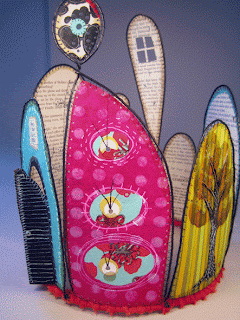
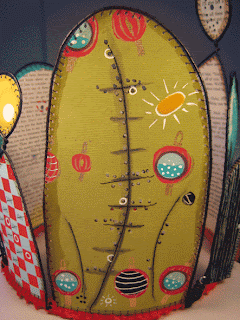
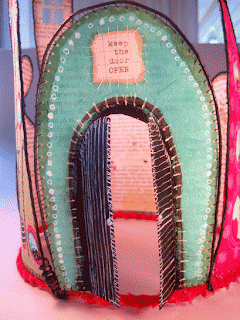


Subscribe to:
Posts (Atom)














